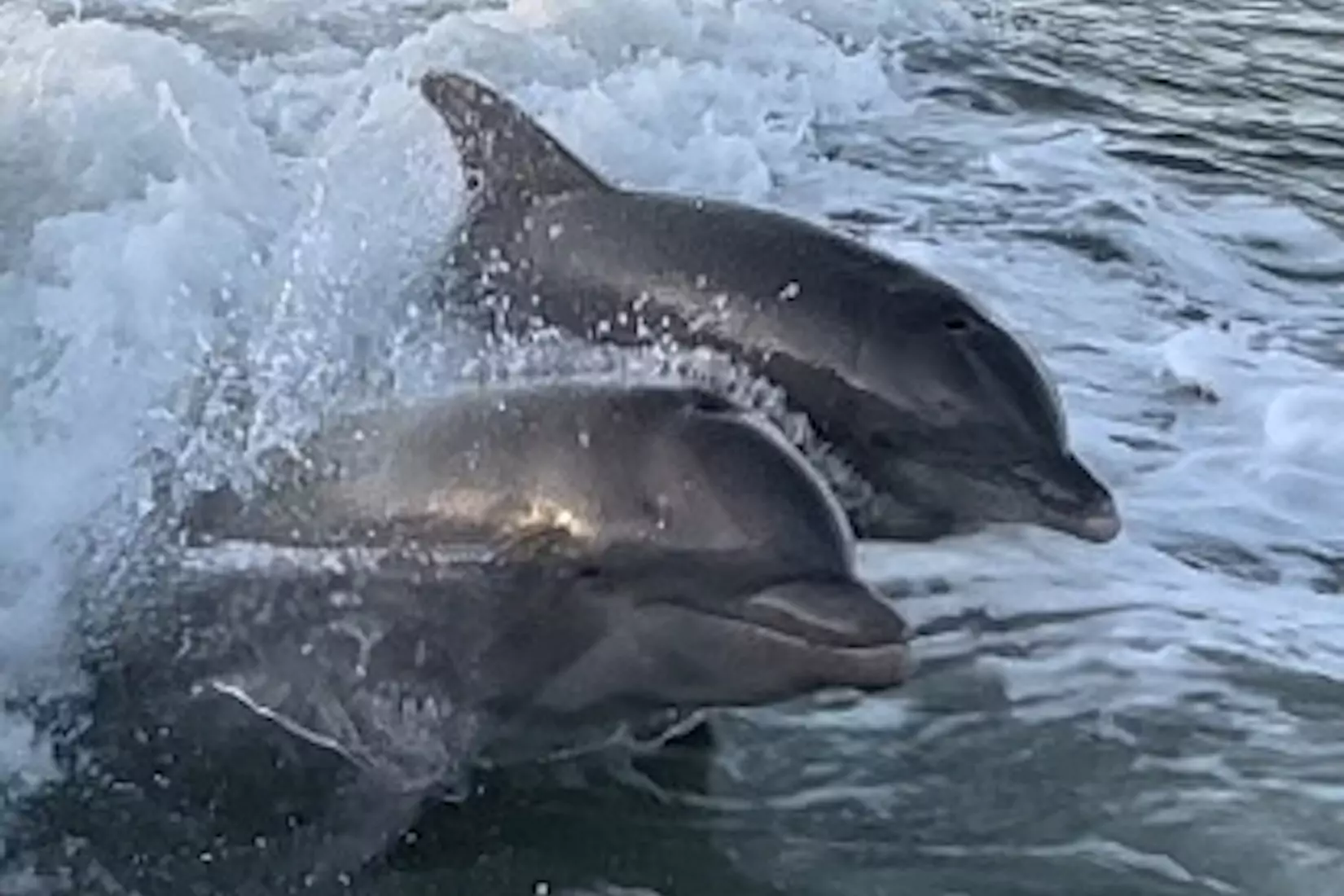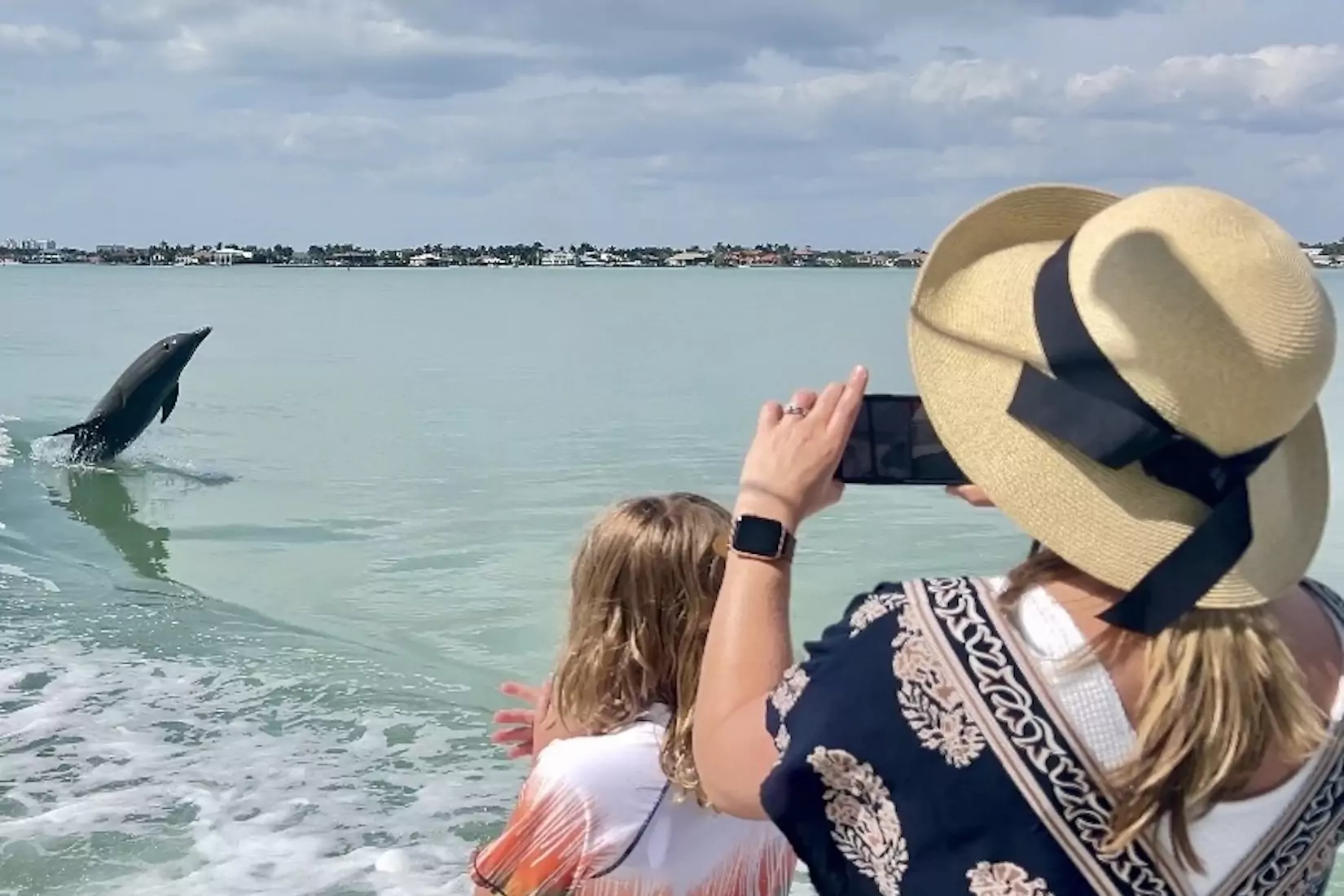Wondering how to see dolphins on Marco Island? Families come to Marco Island for sunshine, soft sand, and a real chance to watch wild dolphins up close. If you’re traveling with kids, you want the moment to feel effortless and safe, not lucky or rushed.
At Florida Island Tours, we treat dolphin encounters like a craft. We use a straightforward, ethical approach that helps us find dolphins predictably while keeping every interaction calm and respectful. This guide explains how we do it, why Marco Island is a reliable place for sightings, and how your family can prepare for a relaxed, photo-ready day on the water.
How to See Dolphins Marco Island (Family Guide)
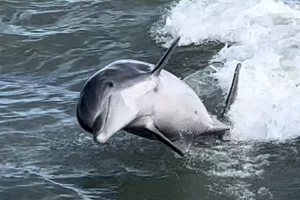
When families ask how to see dolphins on Marco Island without guessing, we talk about three ingredients: water movement, bait, and routes. Moving water pulls or pushes bait, bait attracts birds and dolphins, and dolphins develop patterns that repeat with the tides. Over a season, those patterns become a map we can trust.
Ethics First, Every Time
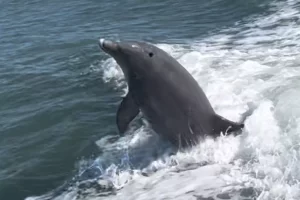
We also believe “no” is sometimes the correct answer. If a pod shows signs of stress—tight formations, quick dives, or consistent avoidance—we change our route. Leaving at the right moment preserves trust for future generations and keeps these waters a welcoming place for wildlife.
How Captains Predictably Find Dolphins
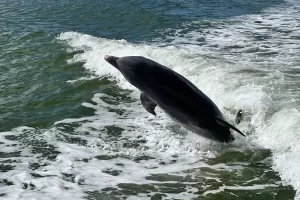
Once we’re on the water, we look for bird activity. Terns and pelicans reveal surface bait, and surface bait hints at dolphins below. We also watch for subtle texture changes. A smooth slick can meet a choppier line where two flows collide, creating a seam that holds food. A small swirl or a V-shaped push against the current can be the first clue that a dolphin just rolled under the surface.
Listening helps too. On calm days, a dolphin’s breath carries across the water with a soft whoof. We often throttle down and let the boat settle so we can hear that sound. One breath can give us the direction we need to set up a respectful approach.
Boat handling plays a big part. Dolphins sometimes choose to surf a clean, steady wake. A smooth pressure line feels like an invitation; an erratic wake turns them away. We hold a consistent speed, keep arcs gentle, and shift our angle with the tide, especially when calves are present. If dolphins come close, we reduce speed or slip into neutral so the encounter remains on their terms.
After every trip, we log where we found dolphins, the water conditions, how the wind and tide lined up, and which routes produced the best viewing. Those notes sharpen our instincts and turn good days into reliable patterns.
Local “Neighborhoods” and Why They Work
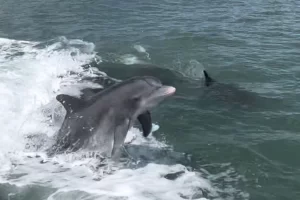
You won’t need to memorize any of that. Your captain already watches the forecast, the tide stages, and yesterday’s notes. But it’s helpful to know that our routes aren’t random. They’re chosen for reasons you can see and understand once we point out the signs.
How to See Dolphins Marco Island – Plan Your Family’s Best Chance
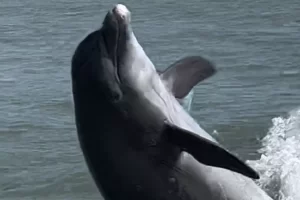
Comfort matters for attention spans. Polarized sunglasses help kids cut glare and see deeper into the green water. A hat with a snug fit keeps faces shaded without becoming a kite in the breeze. Quick-dry layers make splashes a non-issue, and a simple phone lanyard saves your best photos from an accidental dip. Little comforts keep everyone tuned in and happy.
If your group includes toddlers, mornings tend to be the sweet spot. Cooler air, gentler wind, and calmer surfaces help them notice more and fuss less. Let us know about ages and any mobility needs when you book, and we’ll adjust the plan so boarding and moving around the boat feel easy.
Help Kids Become Spotters
Kids love a job, so we give them one. Before we reach a likely area, we explain how to watch the water rather than the distant horizon. We ask them to notice arrow-shaped ripples that point into the current and to keep an ear out for that soft breath. When a dolphin surfaces, we talk about direction—was it moving left to right, or aiming toward the seam—and we predict where the next breath might be.
That slight shift, from passive watching to active noticing, changes the whole experience. Children start to read the water with us. When they spot a fin before anyone else, the moment becomes theirs.
What You Might See
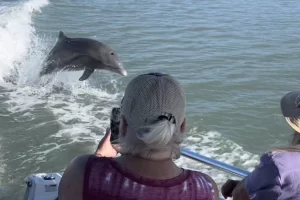
We pay close attention when calves are present. Mothers need room to nurse, rest, and teach. By easing off earlier and widening our arc, we give them the space to choose how long they want to stay near us.
How to See Dolphins Marco Island – Photography Tips
Your phone is enough. The most crucial technique is anticipation, not equipment. Hold the phone comfortably at chest height and keep the horizon level. When a dolphin surfaces, consider using burst mode for a few seconds rather than chasing focus between shots. Later, you can pick the sharpest frame. If you wear polarized sunglasses, try tipping them up momentarily while you shoot; glasses help you spot, but they can darken a screen and make framing tricky.
Morning light has a way of shaping dorsal fins so they stand out against the water. Overcast skies are surprisingly forgiving, too, because they reduce harsh glare. If you take a short video and then scrub through frame by frame later, you’ll often find one perfect still you can save and share.
Safety and Comfort on Board
We run clean, stable boats with cushioned seating and sturdy railings so families feel secure the moment they step aboard. You’ll find properly sized life jackets for every age, a well-stocked first aid kit, dry storage for phones and snacks, and non-slip decks that rinse quickly. Captains hold professional licenses and practice emergency procedures regularly. More importantly, safety shows up in the small decisions—how we time our departures, which lanes we choose, how we manage the throttle when wildlife approaches, and when we decide to change course for comfort.
A Morning That Shows the Process
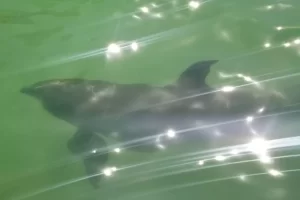
Their daughter pointed first. A fin broke the surface, then vanished. We watched the direction, eased the bow a few degrees with the current, and waited. The same dolphin surfaced nearer, and then another joined it. For a few minutes, the pair rode a clean slice of our wake, popping into the pressure line and then peeling back into the seam. The kids counted breaths and guessed where the next fin would appear. They guessed right more than once.
The best part wasn’t the ride-along. It was the way the family fell into the rhythm of the water—quiet, attentive, and delighted by small clues. That’s the feeling we try to create every day.
Weather: What Matters and What Doesn’t
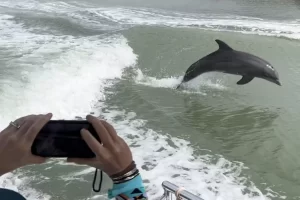
We always watch the forecast and adapt routes to keep the ride easy. If conditions push us away from open edges, we may spend more time in protected back-bays where surface texture stays readable.
Answers to Questions Families Ask Most About How to See Dolphins Marco Island
How long is the right tour length?
Two to three hours gives us time to follow a tide stage and explore multiple lanes. That window also leaves space for a quick shelling stop on a barrier island if your group wants a mix. Many families tell us the combo—dolphins first, then a short beach break—keeps kids happy from start to finish.
What happens if we don’t see dolphins right away?
We change the angles, try a different seam, or move to another neighborhood. Because we track patterns daily, we have several options in mind before we leave the dock. While we pivot, we stay curious about everything else around us. You might spot manatees near the edges, or watch pelicans dive so close you’ll hear the splash.
Are tours suitable for toddlers and teens together?
Yes, and planning makes the difference. Morning departures favor younger kids. Teens enjoy the photography challenge, so we coach them on anticipation and framing. It helps to let teens share spotter duties and lead the first predictions.
Does noise matter?
It does. Loud voices and sudden movements can shorten an encounter. We use a simple quiet-voices-near-the-pod rule. This isn’t about shushing excitement; it’s about keeping the space calm so the dolphins want to stay nearby.
What’s the best season to visit?
Dolphins live here year-round. Seasonal wind patterns change, which routes feel best, but the fundamentals—tide, bait, and lanes—stay the same. Your captain will plan around the day you arrive, not a generic calendar.
Can we see dolphins without a tour?
You can, especially from beaches or public docks on calm days, but results vary. Tours raise your odds because captains combine tide timing, real-time bird signals, and daily logs to decide where to go. If you’re traveling with kids and want a sure, easy plan, a guided trip simplifies everything.
Captain’s Tip
Teach your kids the “Three-Breath Triangle.” When a dolphin surfaces, notice its direction. Count to three at a relaxed pace while you track that line with your eyes. Then look a little ahead and a little outward from where the dolphin was headed. Many dolphins breathe again near that point, and kids love it when their prediction matches the next fin.
Fun Fact
Every bottlenose dolphin has a unique signature whistle, much like a name. Mothers repeat it to calves for weeks after birth, and pod members recognize one another by those sounds. Researchers identify individuals using these whistles, and on quiet days, you can sometimes hear the chatter carry across the water from well beyond the boat.
How to See Dolphins Marco Island – Choose Florida Island Tours
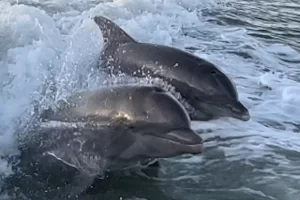
Planning is simple. Tell us what matters most—dolphins first, a barrier-island beach walk, or an early finish for nap time—and we’ll choose the tide window and route that suits your day. You’ll receive clear directions for parking and meeting on the dock, plus tips to make boarding smooth and stress-free. When you step on the boat, you’ll feel prepared rather than rushed. Call or text us, or book your dolphin tour online.
How to See Dolphins Marco Island – The Bottom Line
Ethical choices make dolphin encounters better, not harder. By giving dolphins room to choose the interaction, we see more natural behavior and enjoy more extended visits. By timing trips with the tide and reading what the water tells us, we turn luck into a plan. And by inviting your kids to help, we turn a boat ride into a shared discovery.
If you’re mapping out how to see dolphins on Marco Island with your family, keep it simple. Florida Island Tours will handle the route, the timing, and the small decisions that create big memories. You bring curiosity, a charged phone, and a sense of wonder. We’ll meet you at the dock and take it from there.



